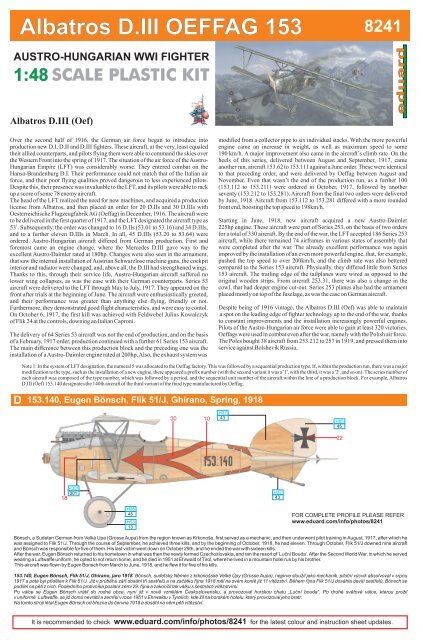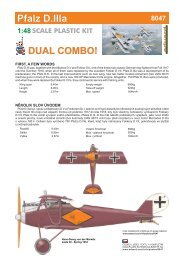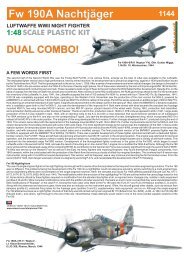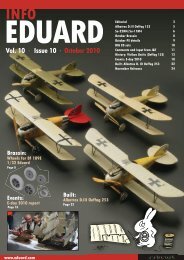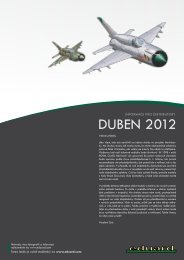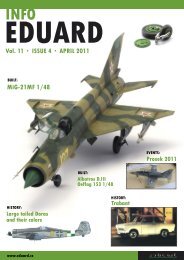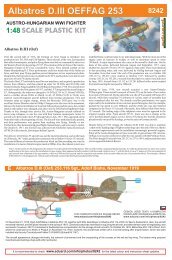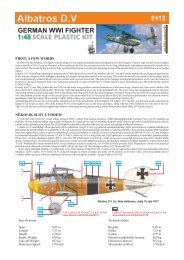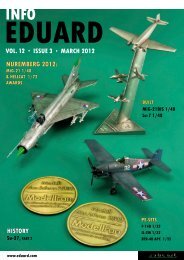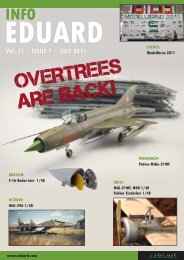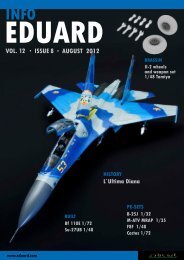Albatros D.III OEFFAG 153 8241 - Eduard
Albatros D.III OEFFAG 153 8241 - Eduard
Albatros D.III OEFFAG 153 8241 - Eduard
Create successful ePaper yourself
Turn your PDF publications into a flip-book with our unique Google optimized e-Paper software.
<strong>Albatros</strong> D.<strong>III</strong> <strong>OEFFAG</strong> <strong>153</strong><br />
AUSTRO-HUNGARIAN WWI FIGHTER<br />
1:48 SCALE PLASTIC KIT<br />
<strong>Albatros</strong> D.<strong>III</strong> (Oef)<br />
Over the second half of 1916, the German air force began to introduce into<br />
production new D.I, D.II and D.<strong>III</strong> fighters. These aircraft, at the very, least equaled<br />
their allied counterparts, and pilots flying them were able to command the skies over<br />
the Western Front into the spring of 1917. The situation of the air force of the Austro-<br />
Hungarian Empire (LFT) was considerably worse. They entered combat on the<br />
Hansa-Brandenburg D.I. Their performance could not match that of the Italian air<br />
force, and their poor flying qualities proved dangerous to less experienced pilots.<br />
Despite this, their presence was invaluable to the LFT, and its pilots were able to rack<br />
up a score of some 78 enemy aircraft.<br />
The head of the LFT realized the need for new machines, and acquired a production<br />
license from <strong>Albatros</strong>, and then placed an order for 20 D.IIs and 30 D.<strong>III</strong>s with<br />
Oesterreichische Flugzeugfabrik AG (Oeffag) in December, 1916. The aircraft were<br />
to be delivered in the first quarter of 1917, and the LFT designated the aircraft type as<br />
1<br />
53 . Subsequently, the order was changed to 16 D.IIs (53.01 to 53.16) and 34 D.<strong>III</strong>s,<br />
and to a further eleven D.<strong>III</strong>s in March. In all, 45 D.<strong>III</strong>s (53.20 to 53.64) were<br />
ordered. Austro-Hungarian aircraft differed from German production. First and<br />
foremost came an engine change, where the Mercedes D.<strong>III</strong> gave way to the<br />
excellent Austro-Daimler rated at 180hp. Changes were also seen in the armament,<br />
that saw the internal installation of Austrian Schwarzlose machine guns, the cockpit<br />
interior and radiator were changed, and, above all, the D.<strong>III</strong> had strengthened wings.<br />
Thanks to this, through their service life, Austro-Hungarian aircraft suffered no<br />
lower wing collapses, as was the case with their German counterparts. Series 53<br />
aircraft were delivered to the LFT through May to July, 1917. They appeared on the<br />
front after trials at the beginning of June. The aircraft were enthusiastically greeted,<br />
and their performance was greater than anything else flying, friendly or not.<br />
Furthermore, they demonstrated good flight characteristics, and were easy to contol.<br />
On October 6, 1917, the first kill was achieved with Feldwebel Julius Kowalczyk<br />
of Flik 24 at the controls, downing an Italian Caproni.<br />
The delivery of 64 Series 53 aircraft was not the end of production, and on the basis<br />
of a February, 1917 order, production continued with a further 61 Series <strong>153</strong> aircraft.<br />
The main difference between this production block and the preceding one was the<br />
installation of a Austro-Daimler engine rated at 200hp. Also, the exhaust system was<br />
18<br />
H301<br />
301<br />
H85<br />
45<br />
H53<br />
13<br />
30<br />
10<br />
H37<br />
43<br />
H37<br />
43<br />
H85<br />
45<br />
22<br />
<strong>8241</strong><br />
Note 1: In the system of LFT designation, the numeral 5 was allocated to the Oeffag factory. This was followed by a sequential production type. If, within the production run, there was a major<br />
modification to the type, such as the installation of a new engine, there appeared a prefix number (with the second variant it was a '1', with the third, it was a '2', and so on). The series number of<br />
each aircraft was composed of the type number, which was followed by a period, and the sequential unit number of the aircraft within the line of a production block. For example, <strong>Albatros</strong><br />
D.<strong>III</strong> (Oef) <strong>153</strong>.140 designates the 140th aircraft of the third variant of the third type manufactured by Oeffag.<br />
D <strong>153</strong>.140, Eugen Bönsch, Flik 51/J, Ghirano, Spring, 1918<br />
Bönsch, a Sudeten German from Velká Upa (Grosse Aupa) from the region known as Krkonoše, first served as a mechanic, and then underwent pilot training in August, 1917, after which he<br />
was assigned to Flik 51/J. Through the course of September, he achieved three kills, and by the beginning of October, 1918, he had eleven. Through October, Flik 51/J downed nine aircraft<br />
and Bönsch was responsible for five of them. His last victim went down on October 29th, and he ended the war with sixteen kills.<br />
After the war, Eugen Bönsch returned to his hometown in what was then the newly formed Czechoslovakia, and ran the resort of ‘Luèn? Bouda’. After the Second World War, in which he served<br />
wearing a Luftwaffe uniform, he opted to not return home, and he died in 1951 at Ehrwald of Tirol, where he lived in a mountain hotel run by his brother.<br />
This aircraft was flown by Eugen Bonsch from March to June, 1918, and he flew it for five of his kills.<br />
<strong>153</strong>.140, Eugen Bönsch, Flik 51/J, Ghirano, jaro 1918. Bönsch, sudetsk? Nìmec z krkonošské Velké Úpy (Grosse Aupa), nejprve sloužil jako mechanik, pilotní výcvik absolvoval v srpnu<br />
1917 a poté byl pøidìlen k Flik 51/J. Již v prùbìhu záøí dosáhl tøí sestøelù a na zaèátku øíjna 1918 mìl na svém kontì již 11 vítìzství. Bìhem øíjna Flik 51/J dosáhla devíti sestøelù, Bönsch se<br />
podílel na pìti z nich. Posledního protivníka poslal k zemi 29. øíjna a zakonèil tak válku s šestnácti vítìzstvími.<br />
Po válce se Eugen Bönsch vrátil do rodné obce, nyní již v novì vzniklém Èeskoslovensku, a provozoval horskou chatu „Luèní bouda“. Po druhé svìtové válce, kterou prožil<br />
v uniformì Luftwaffe, se již domù nevrátil a zemøel v roce 1951 v Ehrwaldu v Tyrolích, kde žil na horském hotelu, který provozoval jeho bratr.<br />
Na tomto stroji létal Eugen Bönsch od bøezna do èervna 1918 a dosáhl na nìm pìti vítìzství.<br />
It is recommended to check www.eduard.com/info/photos/<strong>8241</strong> for the latest colour and instruction sheet updates.<br />
eduard<br />
modified from a collector pipe to six individual stacks. With the more powerful<br />
engine came an increase in weight, as well as maximum speed to some<br />
190 km/h. A major improvement also came in the aircraft’s climb rate. On the<br />
heels of this series, delivered between August and September, 1917, came<br />
another run, aircraft <strong>153</strong>.62 to <strong>153</strong>.111 against a June order. These were identical<br />
to that preceding order, and were delivered by Oeffag between August and<br />
November. Even that wasn’t the end of the production run, as a further 100<br />
(<strong>153</strong>.112 to <strong>153</strong>.211) were ordered in October, 1917, followed by another<br />
seventy (<strong>153</strong>.212 to <strong>153</strong>.281). Aircraft from the final two orders were delivered<br />
by June, 1918. Aircraft from <strong>153</strong>.112 to <strong>153</strong>.281 differed with a more rounded<br />
front end, boosting the top speed to 198km/h.<br />
Starting in June, 1918, new aircraft acquired a new Austro-Daimler<br />
225hp engine. These aircraft were part of Series 253, on the basis of two orders<br />
for a total of 330 aircraft. By the end of the war, the LFT accepted 186 Series 253<br />
aircraft, while there remained 74 airframes in various states of assembly that<br />
were completed after the war. The already excellent performance was again<br />
improved by the installation of an even more powerful engine, that, for example,<br />
pushed the top speed to over 200km/h, and the climb rate was also bettered<br />
compared to the Series <strong>153</strong> aircraft. Physically, they differed little from Series<br />
<strong>153</strong> aircraft. The trailing edge of the tailplanes were wired as opposed to the<br />
original wooden strips. From aircraft 253.31, there was also a change in the<br />
cowl, that had deeper engine cut-out. Series 253 planes also had the armament<br />
placed mostly on top of the fuselage, as was the case on German aircraft.<br />
Despite being of 1916 vintage, the <strong>Albatros</strong> D.<strong>III</strong> (Oef) was able to maintain<br />
a spot on the leading edge of fighter technology up to the end of the war, thanks<br />
to constant improvements and the installation increasingly powerful engines.<br />
Pilots of the Austro-Hungarian air force were able to gain at least 320 victories.<br />
Oeffags were used in combat even after the war, namely with the Polish air force.<br />
The Poles bought 38 aircraft from 253.212 to 257 in 1919, and pressed them into<br />
service against Bolshevik Russia.<br />
FOR COMPLETE PROFILE PLEASE REFER<br />
www.eduard.com/info/photos/<strong>8241</strong>
2<br />
ATTENTION UPOZORNÌNÍ<br />
ACHTUNG ATTENTION<br />
GB<br />
CZ<br />
F<br />
D<br />
JP<br />
INSTRUCTION SIGNS<br />
OPTIONAL<br />
VOLBA<br />
FACULTATIF<br />
NACH BELIEBEN<br />
Carefully read instruction sheet before assembling. When you use glue or paint, do not use near open flame and use in well ventilated room. Keep out of<br />
reach of small children. Children must not be allowed to suck any part, or pull vinyl bag over the head.<br />
Pøed zapoèetím stavby si peèlivì prostudujte stavební návod. Pøi používání barev a lepidel pracujte v dobøe vìtrané místnosti. Lepidla ani barvy<br />
nepoužívejte v blízkosti otevøeného ohnì. Model není urèen malým dìtem, mohlo by dojít k požití drobných dílù.<br />
Iire soigneusement la fiche d´instructions avant d´assembler. Ne pas utiliser de colle ou de peinture `a<br />
p roximité d´une flamme nue, et aérer la piece de<br />
temps en temps. Garder hors de portée des enfants en bas âge. Ne pas laisser les enfants mettre en bouche ou sucer les pièces, o u p asser u n s achet v inyl s ur<br />
la t ete.<br />
Von dem Zusammensetzen die Bauanleitung gut durchlesen. Kleber und Farbe nicht nahe von offenem Feuer verwenden und das Fenster von Zeit zu Zeit<br />
Belüftung öffnen. Bausatz von kleinen Kindern fernhalten. Verhüten Sie, daß Kinder irgendwelche Bauteile in den Mund nehmen oder Plastiktüten über<br />
den Kopf ziehen.<br />
BEND<br />
OHNOUT<br />
PLIER SIL VOUS PLAIT<br />
BITTE BIEGEN<br />
INSTR. SYMBOLY INSTRUKTION SINNBILDEN SYMBOLES<br />
OPEN HOLE<br />
VYVRTAT OTVOR<br />
FAIRE UN TROU<br />
OFFNEN<br />
SYMETRICAL ASSEMBLY<br />
SYMETRICKÁ MONTÁŽ<br />
MONTAGE SYMÉTRIQUE<br />
SYMMETRISCHE AUFBAU<br />
NOTCH<br />
ZÁØEZ<br />
L INCISION<br />
DER EINSCHNITT<br />
REMOVE<br />
ODØÍZNOUT<br />
RETIRER<br />
ENTFERNEN<br />
PARTS DÍLY<br />
TEILE PIECES<br />
PLASTIC PARTS<br />
A> B> C><br />
1<br />
9<br />
14<br />
4<br />
D> X><br />
7<br />
3<br />
5<br />
2 3<br />
5<br />
10<br />
15<br />
2<br />
6<br />
6<br />
11<br />
16<br />
1<br />
8<br />
7 8<br />
12<br />
17<br />
19 20 21 21<br />
23<br />
4<br />
eduard<br />
COLOURS BARVY<br />
FARBEN PEINTURE<br />
GSi Creos (GUNZE)<br />
AQUEOUS<br />
26<br />
22<br />
24 25<br />
Mr.COLOR<br />
H 4 C4<br />
YELLOW<br />
H 12 C33 FLAT BLACK<br />
H 13<br />
C3<br />
13<br />
FLAT RED<br />
H 37 C43 WOOD BROWN<br />
H 47<br />
H 53<br />
H 67<br />
C41<br />
C13<br />
C115<br />
RED BROWN<br />
18<br />
NEUTRAL GRAY<br />
LIGHT BLUE<br />
H 73 C23 DARK GREEN<br />
4<br />
25<br />
9<br />
9<br />
15<br />
22<br />
1<br />
5<br />
1<br />
2<br />
3<br />
6<br />
10 11 12 13 14<br />
16<br />
26<br />
17<br />
5<br />
6<br />
7<br />
10 10<br />
11 11<br />
2<br />
7<br />
18 19 20<br />
23<br />
27<br />
24<br />
AQUEOUS<br />
13<br />
8<br />
3<br />
21<br />
12<br />
28<br />
28<br />
8<br />
Mr.COLOR<br />
H 85 C45 SAIL COLOR<br />
H 301 C301 GRAY<br />
H 344 RUST<br />
Mr.METAL COLOR<br />
MC214 DARK IRON<br />
MC218 ALUMINIUM<br />
MC219 BRASS<br />
Mr. COLOR SUPER<br />
METALLIC<br />
SM01 SUPER CHROME<br />
2<br />
APPLY EDUARD MASK<br />
AND PAINT<br />
POUŽÍT EDUARD MASK<br />
NABARVIT<br />
4 5<br />
6<br />
8<br />
PE - PHOTO ETCHED<br />
DETAIL PARTS<br />
1<br />
10<br />
9<br />
7<br />
3
X8<br />
MC218<br />
ALUMINIUM<br />
PE28<br />
X10<br />
MC218<br />
ALUMINIUM<br />
H 12<br />
C33<br />
FLAT BLACK<br />
X2 X10<br />
H 47<br />
C41<br />
RED BROWN<br />
PE10<br />
PE34<br />
PE27<br />
decal 49<br />
H 301<br />
C301<br />
GRAY<br />
MC218<br />
ALUMINIUM<br />
A23<br />
X11<br />
A23<br />
MC218<br />
ALUMINIUM<br />
MC214<br />
DARK IRON<br />
H 301<br />
C301<br />
GRAY<br />
A20<br />
H 301<br />
C301<br />
GRAY<br />
MC218<br />
ALUMINIUM<br />
A9<br />
H 37<br />
C43<br />
WOOD BROWN<br />
X9<br />
X1<br />
MC218<br />
ALUMINIUM<br />
PE13<br />
X11<br />
H 12<br />
C33<br />
FLAT BLACK<br />
PE3<br />
PE38<br />
H 301<br />
C301<br />
GRAY<br />
MC218<br />
ALUMINIUM<br />
PE15<br />
PE14<br />
PE30<br />
PE31<br />
PE1<br />
B17<br />
PE38<br />
MC218<br />
ALUMINIUM<br />
A13<br />
B , C , D<br />
MARKING ONLY<br />
DON´T PAINT<br />
NEBARVIT<br />
PE16<br />
X3<br />
X5<br />
DON´T PAINT<br />
NEBARVIT<br />
H 301<br />
C301<br />
GRAY<br />
PE17<br />
DON´T PAINT<br />
NEBARVIT<br />
B2<br />
PE4<br />
PE20<br />
H 301<br />
C301<br />
GRAY<br />
X6<br />
MC218<br />
ALUMINIUM<br />
H 37<br />
C43<br />
WOOD BROWN<br />
X5<br />
A17<br />
MC214<br />
DARK IRON<br />
PE25<br />
H 12<br />
C33<br />
FLAT BLACK<br />
PE1<br />
PE3<br />
X3<br />
MC218<br />
ALUMINIUM<br />
X12<br />
X7<br />
PE9<br />
decal 48<br />
PE12<br />
X13<br />
H 12<br />
C33<br />
FLAT BLACK<br />
H 37<br />
C43<br />
WOOD BROWN<br />
decal 51<br />
PE2<br />
PE4<br />
B18<br />
X13<br />
H 12<br />
C33<br />
FLAT BLACK<br />
3
4<br />
C1<br />
B9<br />
MC218<br />
ALUMINIUM<br />
H 37<br />
C43<br />
WOOD BROWN<br />
H 301<br />
C301<br />
GRAY<br />
PE11<br />
MC214<br />
DARK IRON<br />
B16<br />
MC214<br />
DARK IRON<br />
B27<br />
B10<br />
H 37<br />
C43<br />
WOOD BROWN<br />
B19<br />
MC214<br />
DARK IRON<br />
C3<br />
A25<br />
C1<br />
H 37<br />
C43<br />
WOOD BROWN<br />
H 301<br />
C301<br />
GRAY<br />
H 37<br />
C43<br />
WOOD BROWN<br />
B7<br />
PE37<br />
MARKING A ; B<br />
C D<br />
LIKE OVERAL CAMOUFLAGE<br />
JAKO CELKOVÉ ZBARVENÍ<br />
C301<br />
H 301<br />
GRAY<br />
PE21<br />
B8<br />
MARKING ; ; E<br />
B21<br />
B18<br />
H 301<br />
C301<br />
GRAY<br />
H 301<br />
C301<br />
GRAY<br />
A1<br />
A2<br />
DON´T PAINT<br />
NEBARVIT<br />
H 301<br />
C301<br />
GRAY<br />
A17<br />
A18<br />
B7<br />
MC218<br />
ALUMINIUM<br />
C3<br />
B11<br />
A13<br />
A14<br />
H 37<br />
C43<br />
WOOD BROWN<br />
MC214<br />
DARK IRON<br />
C3<br />
A4<br />
H 37<br />
C43<br />
WOOD BROWN<br />
H 37<br />
C43<br />
WOOD BROWN<br />
B20<br />
A19<br />
C10<br />
H 47<br />
C41<br />
RED BROWN<br />
C10<br />
A16<br />
H 12<br />
C33<br />
FLAT BLACK<br />
H 37<br />
C43<br />
WOOD BROWN<br />
PE19<br />
PE18 decal 53<br />
decal 52<br />
PE5<br />
A16<br />
MC218<br />
ALUMINIUM<br />
A10
C2<br />
B23 H 344<br />
D8<br />
RUST<br />
D3<br />
C8<br />
D7<br />
PE29<br />
SM01<br />
H 12<br />
SUPER CHROME C33<br />
FLAT BLACK<br />
D4<br />
MARKING E ONLY MARKING A ONLY<br />
X6 X6<br />
MC218<br />
ALUMINIUM<br />
C4<br />
MARKING E ONLY<br />
H 12<br />
C33<br />
FLAT BLACK<br />
H 12<br />
C33<br />
FLAT BLACK<br />
PE22<br />
PE29<br />
D5<br />
MC218<br />
ALUMINIUM<br />
C6<br />
D1<br />
DECAL 45<br />
DECAL 23+ 24<br />
D6<br />
D4<br />
D4<br />
5
6<br />
A8<br />
PE33<br />
A21<br />
A7<br />
H 301<br />
C301<br />
GRAY<br />
B6<br />
MC219<br />
BRASS<br />
H 37<br />
C43<br />
WOOD BROWN<br />
B26<br />
H 301<br />
C301<br />
GRAY<br />
PE35<br />
H 301<br />
C301<br />
GRAY<br />
A11<br />
A15<br />
A12<br />
MC219<br />
BRASS<br />
H 301<br />
C301<br />
GRAY<br />
A6<br />
B5<br />
A21 PE33<br />
PE24<br />
D4<br />
H 301<br />
C301<br />
GRAY<br />
B4<br />
C301<br />
H 301<br />
GRAY<br />
A6, B6<br />
PE35<br />
LONGER AHEAD<br />
A8,<br />
B4<br />
FWD<br />
MARKING B ONLY<br />
H 53<br />
C13<br />
NEUTRAL GRAY<br />
H 12<br />
C33<br />
FLAT BLACK<br />
PE41<br />
PE40 H 12<br />
C33<br />
FLAT BLACK<br />
H 301<br />
C301<br />
GRAY<br />
B15<br />
B4<br />
H 37<br />
C43<br />
WOOD BROWN<br />
PE36
MARKING C ; D ; E<br />
PE23<br />
PE32<br />
H 301<br />
C301<br />
GRAY<br />
MARKING A ; B<br />
B3<br />
A3<br />
A3<br />
PE26+ PE39<br />
PE39<br />
PE26+ PE39<br />
PE26<br />
H 301<br />
C301<br />
GRAY<br />
H 301<br />
C301<br />
GRAY<br />
7
A <strong>153</strong>.27, Georg Kenzian, Flik 55/J, Pergine, Winter, 1917<br />
This aircraft was accepted by the air force in September, 1917, and attached to Flik 55/J, where it became the personal plane of Georg Kenzian von Kenzianshausen. On this aircraft,<br />
he gained his fourth and fifth victories on the 18th and 27th of November, 1917. This plane was damaged on landing and stricken off charge in January, 1918.<br />
Kenzian began his flying career as an observer with Flik 24. His first victory was gained with his pilot, Rudolf Forst on June 16th, 1916, the victim being a Farman, and four days later came the<br />
next victory, with the pilot being Josef Kiss. However, at the end of July, the crew of Alois Jezek and Georg Kenzian were shot down by a group of Italian fighters. After recovering, service at<br />
a flight school, and pilot training, Kenzian was transfered to Flik 55/J as a deputy commander in August, 1917. Here, he scored further kills, and by March, 1918, he would raise his tally to nine.<br />
At the end of the war, he served as Co of Flik 68/J and 42/J.<br />
<strong>153</strong>.27, Georg Kenzian, Flik 55/J, Pergine, zima 1917. Tento stroj pøevzalo letectvo v záøí 1917 a pøidìlilo jej k Flik 55/J, kde se stal osobním strojem Georga Kenziana von Kenzianshausen.<br />
Ten na nìm 18. a 27. listopadu 1917 dosáhl svého ètvrtého a pátého vítìzství. Avšak v prosinci byl stroj poškozen pøi pøistání a následnì v lednu 1918 zrušen.<br />
Kenzian zahájil svou bojovou kariéru letce - pozorovatele u Flik 24. Prvního vítìzství dosáhl spolu se svým pilotem Rudolfem Forstem 16. èervna 1916, kdy mu padl za obì� nepøátelský<br />
Farman, úspìch si ètyøi dny nato zopakoval, tentokráte byl pilotem Josef Kiss. Ovšem na konci èervence osádku Alois Ježek – Georg Kenzian sestøelila skupina italských stíhaèù. Po léèení,<br />
službì v letecké škole a pilotním výcviku byl Kenzian v srpnu 1917 zaøazen k Flik 55/J jako Chefpilot (zástupce velitele). Zde ke svým dvou dosavadním vítìzstvím pøidával další a jeho skóre<br />
se zastavilo v bøeznu 1918 na èísle devìt. Na konci války sloužil jako velitel Flik 68/J a 42/J.<br />
8<br />
?<br />
H37<br />
43<br />
23 ? 27<br />
26b<br />
ALUMINIUM<br />
LIGHT BLUE<br />
45<br />
H67<br />
115<br />
H301<br />
301<br />
?<br />
H73<br />
23<br />
WOOD<br />
45<br />
H67<br />
115<br />
H37<br />
43<br />
H73<br />
23<br />
H53<br />
13<br />
GREY<br />
23 ? 27<br />
H53<br />
13<br />
1<br />
40<br />
41<br />
42 43<br />
DARK GREY H301<br />
301<br />
1<br />
H73<br />
23<br />
DARK GREEN H73<br />
23<br />
25<br />
H73<br />
23<br />
H37<br />
43<br />
H73<br />
23<br />
26b<br />
25<br />
eduard
B <strong>153</strong>.52, Godwin Brumowski, Flik 41/J, Passarella, February, 1918<br />
Godwin Brumowski, with 39 kills, was the most successful Austro-Hungarian pilot. Often, his aircraft were adorned with colorful markings. This applies to aircraft <strong>153</strong>.52, in which he downed<br />
two opponents, and in which he was himself shot down. Red paint was applied over the lacquered natural surface. The application was fairly thick, and it gave the impression of a monotone<br />
color application. Onto this background were applied light colored "tresses". The skull became a personal marking of Brumowski’s airplanes in later stages of the war. Also worth noting is the<br />
horseshoe for luck on the interwing strut, which was quite common installation within Flik 41/J’s Oeffags.<br />
<strong>153</strong>.52, Godwin Brumowski, Flik 41/J, Passarella, únor 1918. Godwin Brumowski byl s 39 sestøely nejúspìšnìjším stíhaèem rakousko-uherského letectva.<br />
Jeho letadla èasto nesla pestré zbarvení. Ani jeho stroj èíslo <strong>153</strong>.52, v nìmž dosáhl dvou vítìzství a v nìmž byl také 4.února 1918 sestøelen, nebyl výjimkou. Na lakovaný pøírodní povrch<br />
stroje byla na všech plochách natupována èervená barva. Tupování bylo velmi husté, takže tvoøilo zdání jednolitého povrchu. Na tento èervený podklad byly pak namalovány svìtlé „lokýnky“.<br />
Umrlèí lebka byla v pozdìjším období války Brumowského osobním symbolem. Za pozornost také stojí podkova pro štìstí na levé mezikøídelní vzpìøe. U Flik 41/J se nejednalo o neobvyklý<br />
doplnìk.<br />
H37<br />
43<br />
27<br />
26a<br />
ALUMINIUM<br />
WOOD<br />
45<br />
H37<br />
43<br />
H13<br />
3<br />
H4<br />
4<br />
H301<br />
301<br />
28<br />
VNITØNÍ STRANA<br />
INNER SIDE<br />
RED<br />
45<br />
H13<br />
3<br />
H13<br />
3<br />
H4<br />
4<br />
H53<br />
13<br />
YELLOW<br />
27<br />
H4<br />
4<br />
37<br />
4 39<br />
GREY<br />
H53<br />
13<br />
34?38<br />
4<br />
H13<br />
3<br />
DARK GREY H301<br />
301<br />
25<br />
H13<br />
3<br />
H37<br />
43<br />
H13<br />
3<br />
28<br />
26a<br />
25<br />
eduard<br />
9
C <strong>153</strong>.137, Josef Novak, Flik 41/J, Torresella, January, 1918<br />
This aircraft was flown by Josef Novák, native of Dobøichov u Kolína. He came to Flik 41/J in June, 1917, and the unit CO, Godwin Brumowski, handpicked him as his wingman. By the end of<br />
summer, 1917, Novák had five kills to his credit (four of which were achieved flying a Hansa-Brandenberg D.I). It is possible that Novák had more kills than that. František Šimek, Brumowski’s<br />
mechanic, noted in his memories that Novák handed some of his kills to the CO for material compensation. It’s unlikely that Josef Novák gained any other confirmed kills by the end of<br />
hostilities. After the war, Novák served in the Czechoslovak Air Force, and from August 1921, he served as factory pilot for Aero company. In 1930, he crashed flying an Aero A-31. Although he<br />
survived serious injuries from this incident, it did contribute to his early death in January, 1934.<br />
<strong>153</strong>.137, Josef Novák, Flik 41/J, Torresella, leden 1918. Na tomto stroji létal Josef Novák, rodák z Dobøichova u Kolína. K Flik 41/J pøišel v èervnu 1917 a velitel jednotky, Godwin<br />
Brumowski, si jej vybral jako svého wingmana. Na konci léta 1917 mìl Novák na svém kontì již pìt potvrzených sestøelù (ètyøi z nich v kabinì Hansa-Brandenburg D.I). Je možné, že ve<br />
skuteènosti Novák sestøelil více nepøátel. František Šimek, Brumowského mechanik, ve svém deníku píše, že Novák nìkterá vítìzství pøenechával za materiální náhradu svému veliteli.<br />
Do konce bojù již Josef Novák pravdìpodobnì žádné další potvrzené vítìzství nezískal. Po válce sloužil Novák u èeskoslovenského letectva a od srpna 1921 byl zamìstnán jako tovární pilot<br />
u továrny Aero. V roce 1930 však pro závadu na øízení letounu Aero A-34 havaroval. By� se z tìžkého zranìní zotavil, následky této nehody byly pøíèinou jeho pøedèasné smrti v lednu 1934.<br />
H37<br />
43<br />
23<br />
22<br />
ALUMINIUM<br />
45<br />
DOPPED LINEN H85<br />
SAIL COLOUR 45<br />
10<br />
18<br />
H301<br />
301<br />
WOOD<br />
45<br />
H85<br />
45<br />
H37<br />
43<br />
H37<br />
43<br />
H85<br />
45<br />
H53<br />
13<br />
GREY<br />
23<br />
H53<br />
13<br />
35<br />
7 36<br />
DARK GREY H301<br />
301<br />
7<br />
H37<br />
43<br />
H37<br />
43<br />
24<br />
H85<br />
45<br />
H37<br />
43<br />
H85<br />
45<br />
29<br />
18<br />
33<br />
H85<br />
45<br />
22<br />
24<br />
eduard
D <strong>153</strong>.186, Flik 55/J, Pergine, May, 1918<br />
It was initially thought that this aircraft was flown by Josef Kiss, the most successful Hungarian ace with 19 kills to his credit. The reason for this was the large white letter ‘K’ and the symbol<br />
resembling a medal on the fuselage. However, Kiss, at the very least, flew Phonix D.IIa 422.10 in the latter half of May, and even died in it. Kiss’s personal marking on the Phonix was a white<br />
stripe around the rear fuselage, and no similar markings were worn on <strong>Albatros</strong> <strong>153</strong>.186. It’s possible that this aircraft belonged to one of the other Flik 55/J pilots who verifiably flew it – Josef<br />
Kos or Oto Kullas. Both survived the war with no victories. This aircraft was destroyed on August 5th, 1918, when it crashed into the water during a mock attack on a target, claiming the life of<br />
Karl Greischberger.It is possible that the light blue color on the lower surfaces extended considerable farther up the fuselage, and even covered the vertical tail surfaces, and then had the<br />
application of camouflage colors onto this.<br />
<strong>153</strong>.186, Flik 55/J, Pergine, kvìten 1918. Pùvodnì se soudilo, že tento stroj patøí Josefu Kissovi, nejúspìšnìjšímu stíhacímu uherskému esu s 19 sestøely na kontì. Dùvodem bylo velké<br />
bílé písmeno „K“ a symbol pøipomínající medaili na trupu. Kiss však minimálnì v druhé polovinì kvìtna létal na Phönixu D.IIa 422.10, na kterém i zahynul. Kissovým osobním markingem na<br />
Phönixu byl bílý pruh pøes záï letounu a ani další Kissovy stroje nenesly symboly podobné tìm na <strong>Albatros</strong>u <strong>153</strong>.186. Je tedy možné, že stroj patøil nìkterému z dalších pilotù Flik 55/J, kteøí<br />
na nìm prokazatelnì létali - Josefu Kosovi nebo Oto Kullasovi. Oba válku pøežili bez jediného vítìzství.Tento letoun podlehl zkáze 5. srpna 1918, kdy s ním pøi cvièné støelbì na cíl s fatálními<br />
následky narazil na vodní hladinu Karl Greischberger. Je možné, že svìtle modrá barva spodních ploch byla na trupu vytažena mnohem výše a pokrývala i SOP. Teprve na tento podklad pak<br />
byly natupovány kamuflážní barvy.<br />
H73<br />
23<br />
H37<br />
43<br />
23<br />
26a<br />
H73<br />
23<br />
ALUMINIUM<br />
LIGHT BLUE<br />
45<br />
H67<br />
115<br />
DOPPED LINEN H85<br />
SAIL COLOUR 45<br />
H73<br />
23<br />
H67<br />
115<br />
45<br />
H67<br />
115<br />
H73<br />
23<br />
H53<br />
13<br />
H85<br />
45<br />
23<br />
31 ?32<br />
31 ? 32<br />
Green camouflage mottles were painted over the natural surfaces (wood, metal, linen).<br />
WOOD<br />
H37<br />
43<br />
GREY<br />
H53<br />
13<br />
DARK GREY H301<br />
301<br />
H73<br />
23<br />
H37<br />
43<br />
H73<br />
23<br />
H37<br />
43<br />
DARK GREEN H73<br />
23<br />
25<br />
H73<br />
23<br />
H85<br />
45<br />
H73<br />
23<br />
H37<br />
43<br />
H85<br />
45<br />
H73<br />
23<br />
26a<br />
H37<br />
43<br />
25<br />
eduard<br />
11
E <strong>153</strong>.140, Eugen Bönsch, Flik 51/J, Ghirano, Spring, 1918<br />
Bönsch, a Sudeten German from Velká Upa (Grosse Aupa) from the region known as Krkonoše, first served as a mechanic, and then underwent pilot training in August, 1917, after which he<br />
was assigned to Flik 51/J. Through the course of September, he achieved three kills, and by the beginning of October, 1918, he had eleven. Through October, Flik 51/J downed nine aircraft<br />
and Bönsch was responsible for five of them. His last victim went down on October 29th, and he ended the war with sixteen kills.<br />
After the war, Eugen Bönsch returned to his hometown in what was then the newly formed Czechoslovakia, and ran the resort of ‘Luèn? Bouda’. After the Second World War, in which he served<br />
wearing a Luftwaffe uniform, he opted to not return home, and he died in 1951 at Ehrwald of Tirol, where he lived in a mountain hotel run by his brother.<br />
This aircraft was flown by Eugen Bonsch from March to June, 1918, and he flew it for five of his kills.<br />
<strong>153</strong>.140, Eugen Bönsch, Flik 51/J, Ghirano, jaro 1918. Bönsch, sudetsk? Nìmec z krkonošské Velké Úpy (Grosse Aupa), nejprve sloužil jako mechanik, pilotní výcvik absolvoval v srpnu<br />
1917 a poté byl pøidìlen k Flik 51/J. Již v prùbìhu záøí dosáhl tøí sestøelù a na zaèátku øíjna 1918 mìl na svém kontì již 11 vítìzství. Bìhem øíjna Flik 51/J dosáhla devíti sestøelù, Bönsch se<br />
podílel na pìti z nich. Posledního protivníka poslal k zemi 29. øíjna a zakonèil tak válku s šestnácti vítìzstvími.<br />
Po válce se Eugen Bönsch vrátil do rodné obce, nyní již v novì vzniklém Èeskoslovensku, a provozoval horskou chatu „Luèní bouda“. Po druhé svìtové válce, kterou prožil<br />
v uniformì Luftwaffe, se již domù nevrátil a zemøel v roce 1951 v Ehrwaldu v Tyrolích, kde žil na horském hotelu, který provozoval jeho bratr.<br />
Na tomto stroji létal Eugen Bönsch od bøezna do èervna 1918 a dosáhl na nìm pìti vítìzství.<br />
H37<br />
43<br />
23<br />
22<br />
ALUMINIUM<br />
DOPPED LINEN H85<br />
SAIL COLOUR 45<br />
18<br />
45<br />
H301<br />
301<br />
WOOD<br />
45<br />
H85<br />
45<br />
H37<br />
43<br />
H37<br />
43<br />
H85<br />
45<br />
H53<br />
13<br />
GREY<br />
23<br />
H53<br />
13<br />
30<br />
10 30<br />
DARK GREY H301<br />
301<br />
10<br />
H37<br />
43<br />
30<br />
H37<br />
43<br />
24<br />
H85<br />
45<br />
H37<br />
43<br />
H85<br />
45<br />
18<br />
H85<br />
45<br />
22<br />
24<br />
eduard
2<br />
13<br />
18<br />
13<br />
12<br />
c EDUARD M.A.,2010<br />
2<br />
21<br />
13<br />
2<br />
13<br />
13<br />
14<br />
STENCIL VARIANTS<br />
19<br />
13 13 13<br />
2<br />
13 13 14<br />
2 2<br />
2<br />
18 13 20 13<br />
13<br />
13<br />
13<br />
13<br />
13<br />
TOP SIDE<br />
13<br />
15 16<br />
2 2<br />
TOP SIDE<br />
BOTTOM SIDE<br />
eduard<br />
www.eduard.com Printed in Czech Republic<br />
2<br />
2 2<br />
2 2<br />
13<br />
18<br />
13<br />
2<br />
3<br />
2+3<br />
5+6<br />
8+9<br />
11+12


